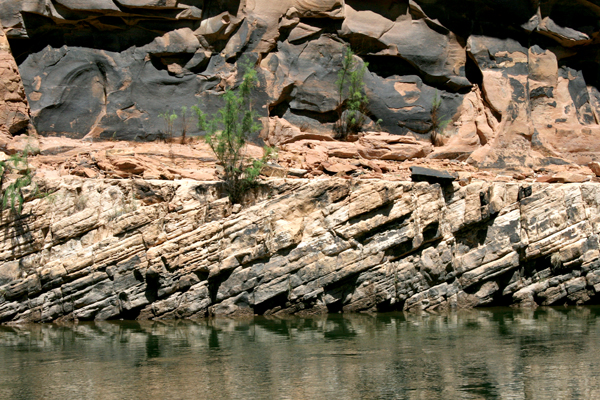
by Steven Newton Thursday, January 5, 2012

Contact of the Toroweap Formation (top) and the Coconino Sandstone (bottom) in the Grand Canyon. Steven Newton
Arizona’s Coconino Sandstone — a deposit seen in the Grand Canyon and elsewhere — plays a central role in the creationist argument that the upper rocks of the Grand Canyon were deposited during Noah’s Flood. In fact, the posters presented by students and faculty of Cedarville University at the 2010 annual meeting of the Geological Society of America (GSA) in Denver, Colo., pushed a consistent narrative: The Coconino did not form in an eolian (wind-blown) environment. Why is this so important? If the Coconino is eolian, it means the Flood did not happen.
Geologists divide the rock exposed at Grand Canyon into three broad groups. The oldest rocks are Precambrian crystalline rocks, followed by the tilted and fragmentary Precambrian Grand Canyon Supergroup, which is then overlain by relatively flat-lying Paleozoic rocks, one of which is the Coconino. When people think of the Grand Canyon, they mostly think of those flat layers of Paleozoic sediments. When a Young-Earth Creationist looks at the same rock, the interpretation is rather different.
As Steve Austin of the Institute for Creation Research explains in his book “Grand Canyon: Monument to Catastrophe,” those Precambrian crystalline rocks represent the original rocks created directly by Yahweh during Creation Week. The second sequence, the Grand Canyon Supergroup, then formed from “catastrophic marine sedimentation and tectonics associated with the formation of an ocean basin midway through Creation Week.” The Precambrian crystalline rocks and the Grand Canyon Supergroup comprised the surface of Earth until the initiation of Noah’s Flood. Then in the year of the Flood, when the whole surface of the planet was covered in water, the Paleozoic rocks — including the Coconino Sandstone — were each laid down in a matter of days in vast, flat, continent-sized sheets. (Non-creationist geologists will tell you these were deposited between about 525 million and 270 million years ago.)
In support of their case, creationists point to the fact that most of the Paleozoic rocks in the Grand Canyon are marine sediments, such as the Kaibab and Redwall limestones. Creationists point to these rocks and rightly say that water was involved, as limestone forms in the ocean. But the creationist Flood model suffers from one terrible, gaping, fatal flaw that threatens everything: the Coconino Sandstone.
The Coconino is an eolian deposit, meaning it records dunes flowing across a dry desert landscape. It is very clearly an eolian deposit, displaying classic wind-blown features such as frosted sand grains and large crossbedding formed from dunes rather than currents. The Coconino is sandwiched between rocks supposedly formed during the year of the Flood, and yet it could only have formed on dry land.
The Coconino sands stick in the eye of the creationist model. Even the president of the Institute for Creation Research, John Morris, admitted, “It is hard to imagine how a desert deposit would develop during the Flood.” Austin also admits that such a formation could not exist in the middle of the Flood. Therefore, creationists are deeply committed to washing away this irritating formation by arguing that the Coconino could have been deposited in a marine environment after all.
The creationist papers at GSA last year used a variety of arguments — such as the presence of dolomite, the degree of sorting — to suggest that the Coconino has been misinterpreted. But their claims remain unconvincing in the face of far simpler interpretations supporting an eolian environment. Nonetheless, in future meetings we can expect to see similar arguments against standard Coconino interpretations, as creationists try to defend a Flood Geology narrative by claiming a marine deposition for the Coconino.
© 2008-2021. All rights reserved. Any copying, redistribution or retransmission of any of the contents of this service without the expressed written permission of the American Geosciences Institute is expressly prohibited. Click here for all copyright requests.